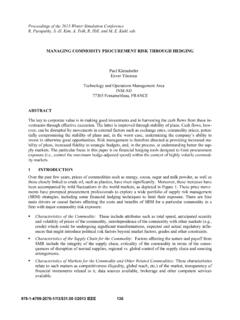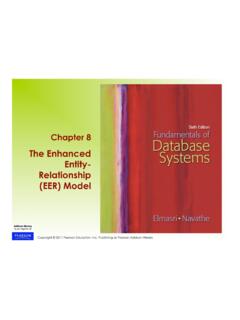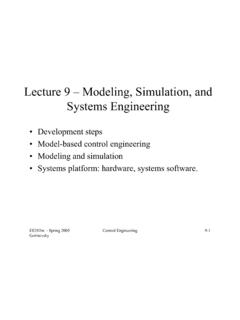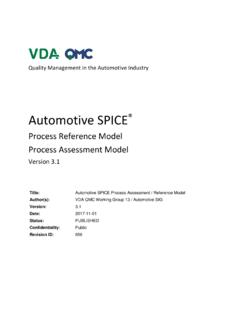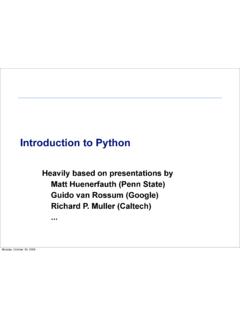Transcription of CONCEPTUAL MODELLING: KNOWLEDGE ACQUISITION …
1 CONCEPTUAL modelling : KNOWLEDGE ACQUISITION AND model abstraction Kathy Kotiadis Stewart Robinson Operational Research and Management Sciences Group Warwick Business School University of Warwick Coventry, CV4 7AL, UNITED KINGDOM ABSTRACT CONCEPTUAL modelling has gained a lot of interest in recent years and simulation modellers are particularly interested in understanding the processes involved in arriving at a CONCEPTUAL model . This paper contributes to this under-standing by discussing the artifacts of CONCEPTUAL model -ling and two specific CONCEPTUAL modelling processes: KNOWLEDGE ACQUISITION and model abstraction . KNOWLEDGE ACQUISITION is the process of finding out about the problem situation and arriving at a system description.
2 model ab-straction refers to the simplifications made in moving from a system description to a CONCEPTUAL model . Soft Systems Methodology has tools that can help a modeller with KNOWLEDGE ACQUISITION and model abstraction . These tools are drawing rich pictures, undertaking analyses one , two , three , and constructing a root definition and the corresponding purposeful activity model . The use of these tools is discussed with respect to a case study in health care. 1 INTRODUCTION This paper focuses on two CONCEPTUAL modelling processes: KNOWLEDGE ACQUISITION and model abstraction . These are explained and then the potential of Soft Systems Method-ology (SSM) to help with both processes is explored.
3 SSM is a problem structuring approach that has previ-ously been combined with discrete event simulation (DES) (Lehaney and Paul 1994a, 1994b; Lehaney and Hlupic 1995; Lehaney and Paul 1996; Lehaney and Paul 1999; Kotiadis 2006; Kotiadis 2007; Pidd 2007 ). However, these studies do not specifically focus on the role of SSM in KNOWLEDGE ACQUISITION and model abstraction . There is, therefore, an opportunity to reflect on SSM s contribution to the process involved in understanding the problematic situation in a rigorous and transparent fashion, and ab-stracting from this situation the CONCEPTUAL model . Al-though we would argue that SSM s main contribution is to problem structuring ( KNOWLEDGE ACQUISITION ), it does also have a role to play in model abstraction .
4 The paper is divided into a further five sections. Sec-tion two provides a brief description of CONCEPTUAL model -ling but then focuses on the artifacts of CONCEPTUAL model -ling. Special attention is paid to the issues that the modeller is faced during the processes of KNOWLEDGE ACQUISITION and model abstraction . In section three SSM is briefly ex-plained and how its various tools can be used to aid and structure the processes of KNOWLEDGE ACQUISITION and mod-el abstraction . In section four we will discuss some of the SSM tools using an example of a health care simulation study. Finally we conclude with suggestions for future re-search. 2 UNDERSTANDING CONCEPTUAL modelling In broad terms, CONCEPTUAL modelling is the process of ab-stracting a model from the real world.
5 The modeller is pre-sented with a problem situation that is amenable to simula-tion modelling and then has to determine what aspects of the real world to include, and exclude, from the model , and at what level of detail to model each aspect. These deci-sions should generally be a joint agreement between the modeller and the problem owners the stakeholders who require the model to aid decision-making. The process of CONCEPTUAL modelling requires deci-sions to be taken regarding the scope and level of detail of the model . It also requires assumptions to be made con-cerning the real world and simplifications to be made to the model . Artifacts of CONCEPTUAL modelling Figure 1 shows the key artifacts of CONCEPTUAL modelling .
6 The arrows in this diagram represent the flow of informa-tion, for instance, information about the real world feeds into the system description. The arrows are not representa-951 978-1-4244-2708-6/08/$ 2008 IEEEP roceedings of the 2008 Winter Simulation ConferenceS. J. Mason, R. R. Hill, L. M nch, O. Rose, T. Jefferson, J. W. Fowler and Robinson tive of the ordering of the steps within the modelling proc-ess, which we know are highly iterative (Balci 1994; Wil-lemain 1995). SystemdescriptionConceptualmod elComputermod elReal worldKnowled ge acquisitionAbstractionModel design& cod ingWhite and black-box validationModel DomainProblem Domain(Assumptions)(Simplifications) Figure 1: Artifacts of CONCEPTUAL modelling The cloud represents the real world (current or fu-ture) within which the problem situation resides.
7 The three rectangles represent specific artifacts of the ( CONCEPTUAL ) modelling process. These are as follows: System description: a description of the problem situation and the system in which the problem sit-uation resides. CONCEPTUAL model : the CONCEPTUAL model is a non-software specific description of the computer simulation model (that will be, is or has been de-veloped), describing the objectives, inputs, out-puts, content, assumptions and simplifications of the model . (Robinson 2008) Computer model : a software specific design and software representation of the CONCEPTUAL model . These artifacts are quite separate. This is not to say that they are always explicitly expressed, with the excep-tion of the computer model .
8 For instance, the system de-scription and the CONCEPTUAL model may not be (fully) do-cumented and can remain within the minds of the modeller and the problem owners. It is, of course, often good mod-elling practice to document both the system description and the CONCEPTUAL model . The computer model is not strictly part of CONCEPTUAL modelling , but it does, of course, embody the CONCEPTUAL model within the code of the model . The computer model , along with model design and coding, and white and black-box validation, are included in Figure 1 for completeness. It is important to recognise the distinction between the system description and the CONCEPTUAL model .
9 The system description relates to the problem domain, that is, it de-scribes the problem and the real world. The CONCEPTUAL model belongs to the model domain in that it describes what parts of the system description will be included in the simulation model and at what level of detail. The authors experience is that these two artifacts are often confused and seen as indistinct. The definitions here are close to those used by Zeigler (1976). The real world is equivalent to Zeigler s base model ; the system description to the experimental frame ; and the CONCEPTUAL model to his lumped model . KNOWLEDGE ACQUISITION and model abstraction in CONCEPTUAL modelling The system description is obtained through KNOWLEDGE ac-quisition.
10 KNOWLEDGE and information about the real world is acquired from subject matter experts (SMEs). The con-ceptual model is obtained through abstraction . The model -ler and problem owners jointly agree on what parts of the system description to model and at what level of detail. We now explore KNOWLEDGE ACQUISITION and model ab-straction in some more detail. KNOWLEDGE ACQUISITION Because the real world is not fully known or knowable, the system description is only a partial representation of the real world. There are limits to the KNOWLEDGE about the real world because: The real world has not been observed in all possi-ble states.
